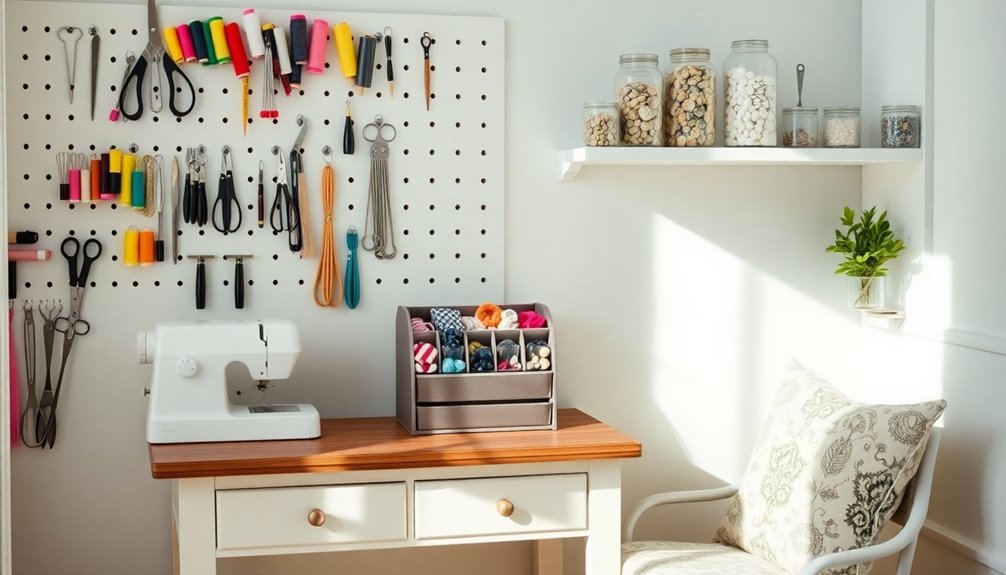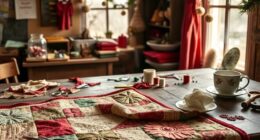Transforming your home sewing space doesn't have to cost a fortune. Start by evaluating your needs and decluttering supplies; clear containers make organization a breeze. Get creative with storage—old furniture or pegboards can work wonders. Multi-functional furniture, like storage ottomans or foldable tables, maximizes space. Add pops of color with decorative labels or plants for inspiration. Want to discover more budget-friendly hacks that enhance your sewing area? Keep exploring to find more tips and ideas!
Key Takeaways
- Repurpose old kitchen cabinets and furniture into functional sewing stations for creative storage solutions on a budget.
- Use clear containers and labeled bins to organize supplies, making it easy to find items while keeping costs low.
- Incorporate vertical storage like pegboards to maximize space without needing expensive furniture.
- Transform vintage trunks or suitcases into stylish storage units, adding character to your sewing area.
- Engage with online communities for budget-friendly inspiration and DIY organization hacks to refresh your sewing space.
Assess Your Sewing Space Needs

How well does your sewing space meet your needs? Start by evaluating its size to guarantee it comfortably accommodates your sewing machine, workspace, and effective storage solutions without feeling cramped.
Identify your primary sewing activities like garment making or quilting to tailor the layout for best organization. Consider how often you use your supplies, prioritizing easy access to essentials and minimizing clutter from rarely used materials.
Natural light plays a vital role, so position your sewing machine near windows for better visibility, and supplement with task lighting if needed.
Finally, reflect on your preferences—do you prefer visible displays of your fabric stash and tools, or hidden storage solutions for a cleaner workspace? Adjust accordingly to create your ideal sewing environment. Additionally, improving your sewing space with better air quality can enhance your overall comfort and creativity while working on projects.
Declutter and Organize Supplies

To create an efficient sewing space, start by decluttering and organizing your supplies.
Here's how you can streamline your craft space:
- Categorize your sewing supplies into groups like threads, fabrics, notions, and tools for easy access.
- Use clear containers and storage bins for small items, labeling each for quick identification and minimizing clutter.
- Repurpose old jars for storing scraps and jelly roll strips, keeping them visible and adding a decorative touch.
- Implement a "one in, one out" rule; for every new item, consider donating or discarding an old one to maintain a clutter-free environment.
Regularly assess your inventory to let go of unused items, freeing up space and enhancing your creativity for new projects.
Creative Storage Solutions

When it comes to organizing your sewing space, getting creative with storage can make a big difference.
You can repurpose furniture, explore vertical storage options, or even craft your own DIY solutions to maximize your area.
Let's uncover some innovative ideas that'll help you keep everything tidy and accessible.
Repurposed Furniture Ideas
Repurposing furniture can breathe new life into your sewing space while adding functional storage solutions.
Here are some creative ideas to maximize accessibility and organization:
- Transform old kitchen cabinets into sewing stations with shelves for fabric and tools, optimizing your workspace.
- Refresh a side table or nightstand with paint and storage bins for stylish storage of sewing notions and small craft supplies.
- Use a sturdy bookshelf to roll and display fabric, utilizing lower shelves for thread and larger tools.
- Convert a vintage trunk or suitcase into a charming mobile storage unit, keeping materials organized and transportable.
Incorporating natural materials can enhance the aesthetic of your sewing space while providing durability and charm.
These repurposed furniture ideas will help you create an organized sewing table, enhancing your overall crafting experience!
Vertical Storage Options
Creating an organized sewing space goes beyond repurposed furniture; incorporating vertical storage options can greatly enhance your setup.
Utilize wall-mounted shelves to store fabric and tools, freeing up floor space while keeping essentials within easy reach. Invest in a peg board, customizing it with hooks and bins to organize sewing tools, making them visible and accessible.
Consider vertical storage bins or cabinets that maximize wall height for your fabric and notions, allowing for more supplies without cluttering the floor. Over-the-door organizers can store smaller items like scissors and threads, transforming unused door space into functional storage.
Finally, repurpose items like old bookcases to create efficient vertical storage solutions for patterns and magazines, helping you declutter your workspace. Additionally, incorporating affordable solutions for pet owners can help keep your sewing area clean and fur-free, especially if you have pets at home.
DIY Storage Solutions
While organizing your sewing space, embracing DIY storage solutions can truly elevate both functionality and style.
Here are some creative ideas to maximize your small space:
- Repurpose old kitchen cabinets as sewing stations, using shelves for fabric storage and keeping everything tidy.
- Store fabric by folding it around comic book boards, promoting uniformity and visibility.
- Create DIY fabric bins by upcycling cardboard boxes, covering them with decorative paper for personalized storage.
- Use clear plastic containers with tight-fitting lids to sort buttons, safety pins, and other tiny supplies for easy access.
These budget-friendly hacks will help you efficiently organize your sewing essentials while adding a unique touch to your space.
Multi-Functional Furniture Ideas

Having a well-organized sewing space can make all the difference, especially when you incorporate multi-functional furniture that adapts to your needs.
Consider investing in a daybed, which can double as a guest sleeping area and a comfy spot to relax during breaks.
A foldable sewing table is perfect for larger projects, easily expanding when needed and tucking away to save space.
Multi-functional storage ottomans offer hidden storage for fabrics and can serve as seating or a footrest.
You can also repurpose an old kitchen island as a mobile cutting table, providing extra storage for tools while being wheeled around your sewing space.
These smart solutions maximize both functionality and comfort in your area, creating a unique atmosphere that enhances your sewing experience.
Setting Up a Functional Workspace

To set up a functional workspace, you need to contemplate both the layout and organization of your sewing area.
Start by evaluating the size of your space to accommodate your sewing machine, cutting area, and storage system effectively.
Here are some sewing room ideas to enhance your setup:
- Position your machine near windows for natural light and add desk lamps for extra visibility.
- Utilize multi-functional furniture, like storage ottomans or folding tables, to maximize your space.
- Organize materials in clear bins or labeled containers for easy access.
- Implement a decluttering routine to maintain an organized sewing area, ensuring only essential tools are at hand.
With these tips, you'll create an efficient and inviting functional workspace!
Incorporating Color and Personal Touches

Creating a functional workspace is just the start of making your sewing area truly yours. Incorporating vibrant colors can enhance your creativity, so consider painting an accent wall or using colorful storage bins to create a lively atmosphere.
Add personal touches by displaying your handmade projects or using fabric swatches as wall art; these inspire new ideas and reflect your unique style. Use decorative labels on storage containers to keep supplies organized while adding a pop of color.
To further enhance the ambiance, incorporate plants or floral arrangements that introduce natural colors and promote a calming environment. Additionally, ensure your space is designed for wellness by including ergonomic furniture that supports comfort during long sewing sessions. With these simple hacks, your sewing space can become a vibrant reflection of your personality and creativity.
Tips for Maintaining Order

To keep your sewing space organized, set up a regular decluttering schedule to remove items you no longer need.
Efficient storage solutions, like clear containers and labeled drawers, can make it easy to find what you're looking for in an instant. Additionally, investing in a home security system can help protect your valuable sewing supplies and equipment from theft.
Regular Decluttering Schedule
While it's easy to let sewing supplies accumulate over time, establishing a regular decluttering schedule can keep your space organized and functional.
Set aside time each week or month to assess sewing supplies and remove items that no longer serve your projects.
Here's how to streamline the process:
- Categorize supplies into "keep," "donate," and "discard."
- Use a timer for focused sessions of 15-30 minutes to avoid feeling overwhelmed.
- Keep a donation box in your sewing space for quick disposal of unwanted items.
- Regularly revisit your storage solutions to guarantee they meet your evolving needs.
Additionally, consider incorporating large indoor plants into your space, as they can enhance both the aesthetic and air quality of your sewing area.
Efficient Storage Solutions
Efficient storage solutions can transform your sewing space into a haven of creativity and productivity, making it easier for you to focus on your projects.
Start by utilizing vertical storage like pegboards and wall-mounted shelves to maximize floor space and keep your tools organized.
Repurpose clear storage bins with labels for storing fabric, notions, and tools, ensuring everything's easy to find.
Implement drawer organizers to keep smaller items such as scissors, pins, and threads neatly separated.
Consider collapsible storage bins that can be tucked away when not in use, offering flexibility for various projects.
Finally, regularly declutter your sewing space by sorting through supplies and removing unused items to maintain an efficient and inviting environment.
Seasonal Cleanup Strategies

As the seasons change, it's the perfect opportunity to refresh your sewing space with a thorough cleanup.
Designate a specific day each season for this seasonal cleanup, focusing on eliminating items that aren't useful for your current projects.
Follow this checklist to streamline your process:
- Evaluate fabric remnants, outdated tools, and patterns unused for over a year.
- Sort through your supplies and categorize them into clear storage bins for easy access.
- Set a routine for tidying up after each project to prevent clutter from accumulating.
- Consider donating unused sewing items to local charities, promoting sustainability and supporting fellow crafters.
Additionally, maintaining a clean sewing space can reduce allergens and pollutants, ensuring a healthier environment for your crafting activities.
Seeking Inspiration From Others

How can you transform your sewing space into a creative haven? Start by seeking inspiration from others.
Engaging with online communities like sewing forums and social media groups can expose you to fantastic organization hacks for your sewing room. Platforms like Pinterest are goldmines for budget-friendly storage ideas, helping you visualize your ideal setup.
YouTube video tours showcase how fellow crafters maximize functionality while keeping their sewing spaces aesthetically pleasing. Additionally, joining local sewing clubs or attending craft fairs offers hands-on inspiration and unique solutions you can implement.
Don't forget to participate in online challenges or share your transformation on social media to foster community engagement and motivate others to showcase their innovative organization strategies. This collaborative approach not only enhances your creativity but also encourages collaboration across diverse teams, leading to a more enriched sewing environment.
Frequently Asked Questions
How to Set up a Sewing Room on a Budget?
To set up a sewing room on a budget, start by repurposing old furniture like kitchen cabinets or side tables for your sewing station.
Use DIY storage solutions, like comic book boards, to organize your fabric.
Grab affordable bins from stores to keep your notions tidy.
Maximize vertical space with pegboards or shelves for tools.
Finally, use clear containers to store small items, so you can easily see what you have without overspending.
What Not to Do in a Sewing Room?
When setting up your sewing room, avoid overcrowding it with unnecessary furniture and decor. Clutter can stifle creativity and efficiency.
Don't neglect proper lighting; poor illumination can strain your eyes and lead to mistakes.
Stay away from non-functional storage solutions that make accessing tools difficult.
Also, don't forget a designated cutting area; cutting on an unsuitable surface can result in errors.
Finally, avoid unorganized piles; use clear bins to keep everything visible and accessible.
What Is the Best Color for a Sewing Room?
Imagine you're creating a cozy sewing haven with soft pastel walls, like a delicate mint green. This color not only calms you but also inspires creativity, making your projects flow effortlessly.
If you want a vibrant space, consider sunny yellows to energize you. Alternatively, neutral tones can help your vibrant fabrics pop.
Ultimately, choose colors that resonate with your style and enhance your sewing experience, creating an inviting atmosphere for your creativity to thrive.
How to Organize Sewing Supplies in a Small Space?
To organize your sewing supplies in a small space, start by using vertical storage solutions like wall-mounted shelves and pegboards.
These keep your materials visible and accessible. Repurpose clear containers and jars for small items, ensuring easy identification.
Utilize drawer organizers to compartmentalize tools, and sort fabric scraps by color using comic book boards.
Finally, establish a Work in Progress (WIP) box system to keep ongoing projects tidy and contained.
Conclusion
Transform your sewing space into a haven of creativity and efficiency. By decluttering your supplies, embracing creative storage, and choosing multi-functional furniture, you'll craft a workspace that inspires. Infuse color and personal touches to make it truly yours, while maintaining order with simple tips. As you tackle seasonal cleanups, remember that an organized space fuels your passion. So, gather your ideas, ignite your inspiration, and watch your sewing sanctuary flourish into a vibrant retreat for your imagination.









